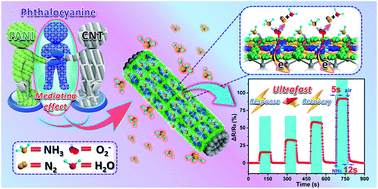当前位置:
X-MOL 学术
›
J. Mater. Chem. A
›
论文详情
Our official English website, www.x-mol.net, welcomes your
feedback! (Note: you will need to create a separate account there.)
Phthalocyanine-mediated non-covalent coupling of carbon nanotubes with polyaniline for ultrafast NH3 gas sensors
Journal of Materials Chemistry A ( IF 10.7 ) Pub Date : 2017-11-06 00:00:00 , DOI: 10.1039/c7ta07443c Hao Wu 1, 2, 3, 4, 5 , Zhimin Chen 1, 2, 3, 4, 5 , Jialin Zhang 1, 2, 3, 4, 5 , Feng Wu 1, 2, 3, 4, 5 , Chunying He 1, 2, 3, 4, 5 , Yiqun Wu 1, 2, 3, 4, 5 , Zhiyu Ren 1, 2, 3, 4, 5
Journal of Materials Chemistry A ( IF 10.7 ) Pub Date : 2017-11-06 00:00:00 , DOI: 10.1039/c7ta07443c Hao Wu 1, 2, 3, 4, 5 , Zhimin Chen 1, 2, 3, 4, 5 , Jialin Zhang 1, 2, 3, 4, 5 , Feng Wu 1, 2, 3, 4, 5 , Chunying He 1, 2, 3, 4, 5 , Yiqun Wu 1, 2, 3, 4, 5 , Zhiyu Ren 1, 2, 3, 4, 5
Affiliation

|
The development of innovative methods for the integration of carbon nanotubes (CNTs) and polyaniline (PANI) that preserve their exceptional quality, while robustly enriching their gas-sensing features, is still rare and remains challenging for the realization of rapid and sensitive gas detection. Herein, due to the advantages in its structure, tetra-β-carboxyphthalocyanine cobalt(II) (TcPcCo) acts not only as a sensing promoter, but also as an efficient mediator to couple multi-walled CNTs (MCNTs) with PANI, resulting in MCNT@PANI hybrids with a uniform 3D network; the planar 18π-electrons in TcPcCo allow it to closely conjugate on the surface of MCNT by π–π interactions; moreover, the outer –COOH groups in TcPcCo prompt it to link with the aniline monomers based on acid–base interactions. During the subsequent polymerization process, TcPcCo also serves as a protonic acid doped into PANI, increasing the electronic conductivity of PANI. Due to the specific selectivity of TcPcCo, high sensitivity of PANI towards NH3, and good conductivity and stability of the MCNTs, the obtained core–shell MCNT@PANI hybrids demonstrate radically enhanced NH3-sensing performance, especially in terms of response/recovery duration (∼5.0 s/12.0 s to 100 ppm NH3) and selectivity, outperforming the single components and previously reported materials at room temperature. In addition, the MCNT@1.0PANI hybrid shows a superior sensing sensitivity (140.99% to 100 ppm NH3) as well as remarkable stability over 60 days. The proposed strategy, TcPcCo-mediated non-covalent coupling of MCNT with PANI, is of potential importance towards the design and construction of ideal materials for future sensing devices, as well as many other applications.
中文翻译:

酞菁介导的碳纳米管与聚苯胺的非共价偶联,用于超快NH 3气体传感器
碳纳米管(CNTs)和聚苯胺(PANI)集成的创新方法的开发仍然很少见,并且在实现快速灵敏的气体检测方面仍保持着挑战,同时又能稳固地丰富其气体传感功能。在此,由于其结构上的优势,四-β-羧基酞菁钴(Ⅱ)(TcPcCo)不仅充当传感促进剂,而且还充当将多壁CNT(MCNT)与PANI耦合的有效介体,从而产生具有统一3D网络的MCNT @ PANI杂种; TcPcCo中的平面18π电子允许它通过π-π相互作用紧密共轭在MCNT的表面上。此外,TcPcCo中的外部–COOH基团促使其基于酸碱相互作用与苯胺单体连接。在随后的聚合过程中,TcPcCo还可以用作掺杂到PANI中的质子酸,从而提高PANI的电子电导率。由于TcPcCo的特定选择性,PANI对NH 3的高敏感性以及MCNT的良好电导率和稳定性,所获得的核-壳MCNT @ PANI杂化物表现出从根本上增强的NH 3-传感性能,特别是在响应/恢复持续时间(约5.0 s / 12.0 s至100 ppm NH 3)和选择性方面,在室温下优于单个组分和先前报道的材料。此外,MCNT @ 1.0PANI杂化体在60天内显示出卓越的感测灵敏度(对于100 ppm NH 3为140.99%)以及出色的稳定性。所提出的策略,即TcPcCo介导的MCNT与PANI的非共价偶联,对于未来感测设备以及许多其他应用的理想材料的设计和构造具有潜在的重要性。
更新日期:2017-11-17
中文翻译:

酞菁介导的碳纳米管与聚苯胺的非共价偶联,用于超快NH 3气体传感器
碳纳米管(CNTs)和聚苯胺(PANI)集成的创新方法的开发仍然很少见,并且在实现快速灵敏的气体检测方面仍保持着挑战,同时又能稳固地丰富其气体传感功能。在此,由于其结构上的优势,四-β-羧基酞菁钴(Ⅱ)(TcPcCo)不仅充当传感促进剂,而且还充当将多壁CNT(MCNT)与PANI耦合的有效介体,从而产生具有统一3D网络的MCNT @ PANI杂种; TcPcCo中的平面18π电子允许它通过π-π相互作用紧密共轭在MCNT的表面上。此外,TcPcCo中的外部–COOH基团促使其基于酸碱相互作用与苯胺单体连接。在随后的聚合过程中,TcPcCo还可以用作掺杂到PANI中的质子酸,从而提高PANI的电子电导率。由于TcPcCo的特定选择性,PANI对NH 3的高敏感性以及MCNT的良好电导率和稳定性,所获得的核-壳MCNT @ PANI杂化物表现出从根本上增强的NH 3-传感性能,特别是在响应/恢复持续时间(约5.0 s / 12.0 s至100 ppm NH 3)和选择性方面,在室温下优于单个组分和先前报道的材料。此外,MCNT @ 1.0PANI杂化体在60天内显示出卓越的感测灵敏度(对于100 ppm NH 3为140.99%)以及出色的稳定性。所提出的策略,即TcPcCo介导的MCNT与PANI的非共价偶联,对于未来感测设备以及许多其他应用的理想材料的设计和构造具有潜在的重要性。











































 京公网安备 11010802027423号
京公网安备 11010802027423号